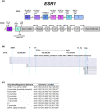Intrinsic and Extrinsic Factors Governing the Transcriptional Regulation of ESR1
- PMID: 32592004
- PMCID: PMC7384552
- DOI: 10.1007/s12672-020-00388-0
Intrinsic and Extrinsic Factors Governing the Transcriptional Regulation of ESR1
Abstract
Transcriptional regulation of ESR1, the gene that encodes for estrogen receptor α (ER), is critical for regulating the downstream effects of the estrogen signaling pathway in breast cancer such as cell growth. ESR1 is a large and complex gene that is regulated by multiple regulatory elements, which has complicated our understanding of how ESR1 expression is controlled in the context of breast cancer. Early studies characterized the genomic structure of ESR1 with subsequent studies focused on identifying intrinsic (chromatin environment, transcription factors, signaling pathways) and extrinsic (tumor microenvironment, secreted factors) mechanisms that impact ESR1 gene expression. Currently, the introduction of genomic sequencing platforms and additional genome-wide technologies has provided additional insight on how chromatin structures may coordinate with these intrinsic and extrinsic mechanisms to regulate ESR1 expression. Understanding these interactions will allow us to have a clearer understanding of how ESR1 expression is regulated and eventually provide clues on how to influence its regulation with potential treatments. In this review, we highlight key studies concerning the genomic structure of ESR1, mechanisms that affect the dynamics of ESR1 expression, and considerations towards affecting ESR1 expression and hormone responsiveness in breast cancer.
Keywords: Chromatin; Gene expression; Steroid receptor; Transcription.
Conflict of interest statement
The authors declare they have no conflicts of interest.
Figures




References
-
- Harvey JM, Clark GM, Osborne CK, Allred DC. Estrogen receptor status by immunohistochemistry is superior to the ligand-binding assay for predicting response to adjuvant endocrine therapy in breast cancer. J Clin Oncol. 1999;17:1474–1481. - PubMed
-
- Allegra JC, Lippman ME, Thompson EB, Simon R, Barlock A, Green L, Huff KK, Do HM, Aitken SC, Warren R. Estrogen receptor status: an important variable in predicting response to endocrine therapy in metastatic breast cancer. Eur J Cancer. 1980;16:323–331. - PubMed
-
- Cook KL, Clarke PA, Parmar J, Hu R, Schwartz-Roberts JL, Abu-Asab M, Warri A, Baumann WT, Clarke R. Knockdown of estrogen receptor-alpha induces autophagy and inhibits antiestrogen-mediated unfolded protein response activation, promoting ROS-induced breast cancer cell death. FASEB Journal : official publication of the Federation of American Societies for Experimental Biology. 2014;28:3891–3905. - PMC - PubMed
Publication types
MeSH terms
Substances
Grants and funding
LinkOut - more resources
Full Text Sources
Miscellaneous

